By end of the 8th century AD, a new chapter had began in the Indian history. It was an arrival of Islam. In Arabia, Islam was born in 6th century AD. Wealthy cities of northern and central India and rich ports of western coast were great temptation for the Arabs who had now united under a newly acquired banner of Islam. The repeated attacks on the Hindu Shahi of Kabul , the proud descendents of Kushan ruler Kanishka was the first successful step. This Brahmanical Shahi of modern Afghanistan, whose rulers patronized various schools of Buddhist and Hindu arts, put up a brave struggle but eventually perished by the end of ninth century AD. Arabs conquored Afghanistan, Baluchistan and Sindh (modern Pakistan) and soon converted it into an Islamic territory. During this period, a good deal of cultural excahnage took place. Arabs acquired from the Indians the knowledge in concepts of philosophy, medicine, mathematics, astronomy and folklore, which they carried to Persia (Iran) and Arabia and eventually to Europe when they conquored Spain. It was in 10th century AD, the second islamic invasion of India took place, carried by Mahmud of Gazni. Mahmud invaded India 17 times, mainly for the acquisition of `wealth of Hindustan'. He took control of of Punjab and later sacked rich city of central India and capital of many of the post-Gupta dynasties, Kanyakubj (modern Kannauj). His expedition against celebrated Hindu Shrine of Somnath, located in modern Gujrath fetched him the massive war booty. The temple was stripped of all its valuables and later destroyed. Overall, Mahmud's all the expeditions were mere annual raids undertaken mainly with the object of plundering wealth of India, destroying temples, desecrating Buddhist, jain and Hindu idols. He carried out massacres of local population (who did not profess islam) and put no efforts to rule the newly acquired parts of his empire.
Mahmud issued atypical coinage. His silver coins are special in Indian numismatics as they have his name written on coins in two different languages. On obverse legends are in Arabic but on reverse the legends are in Sanskrit, written in Devnagri script! The legend on reverse reads Avyaktamekam Muhammad Avatar Nrupati Mahmud in center and around it, the legends reads Avyaktiya Name Ayam Tankam Hato Mahmudpur Sanvanto 418. Obviously, the local population did not know Arabic, a foreign language and this fact made him issue these bilingual coins, a phenonmenon not new to North-Western India. Earlier Indo-Greeks and Kushan also minted bilingual coins where on obverse legends were in Greek while on reverse they were engraved in local Kharoshti script. Well, history does repeat itself!
Coins of Early Islamic Dynasties
The second battle of Terain (near Panipat) laid the foundation of Muslim dominion in northern India. Shown below is the gold coin of Muhammad Ghori depicting four armed Laxmi on reverse which is highly stylized version from Gupta coins and later medieval Rajput dynasties . On obverse, the legends are in Devanagri script which reads Srimad Hamir Mahamad Sam. This is a rare example where a Muslim King issued the coin depicting Hindu deity, possibly of widespread acceptance of Laxmi depicting coins by majority of population and merchants during post-Gupta era.
Coins of Slave Dynasty of Delhi
Like his predecessor Mahmud of Gazni, Ghori too hardly paid any attention in ruling the region that he conquored. He just indulged himself in collecting the largest possible war booty and in that process carried out mass massacre of local population. He could not enjoy his newly acquired wealth. He was murdered in his camp in cold blood while on the way back home to Afghanistan, probably by the group of people whose families were massacred. Ghori had no son and this was an opportunity which made his Turkish general, Qutb-ud-din Aibak to take over this sultanate of Delhi. Qutub thus established the first muslim dynasty of India. This dynasty is popularly called as Slave dynasy since Qutub had been slave of Ghori and later became his most trusted General. He was the major force in incorporating all the neighbouring Hindu kingdoms viz. Banaras and Kanauj (of Jaichand or Jaichandra ), Hansi, Merath, Ranthambor, Bundelkhand into the first islamic empire of India. He died leaving no male heir and which resulted in another power struggle resulting in a favour of Iltutmish, another Turkish Slave. Like his master Qutub, Iltutmish too began as a slave but because of his merits was manumitted and later even managed to mary his master's daughter! Iltutmish faced a lot of rebellions but he swiftly acted and effectively suppressed all of them, keeping him in complete control of his sultanate. He later even received a robe of honour from Khalifa of Baghdad (the religious head of all muslims) confirming as a Sultan-i-Azam, the great sultan. On his coins he describe himself as lieutanant of the Khalifa. He died in 1236 AD after reigning for 26 years. Iltutmish can be considered as the best of all the Turkish sultans who ruled from Delhi. He consolidated the muslim dominion in India and also extended patronage to arts. He completed the famous Qutub Minar, a minarate near Delhi (named after a Sufi saint NOT after his father-in-law) , the tallest among all the pre-modern structures and nearby mosque (considered to be the first mosque of India) at Delhi which was started by his master and father-in-law Qutub-ud-din-Aibak.
Iltutmish did something which happened only once in entire Islamic history of India. On his deathbed he nominated his daughter Raziyya to succeed him as heiress to throne. The brothers of Raziyya were utter hopeless and she was left on her own to rule large part of India. She was not the welcome ruler and practically all her nobles hated the fact that they were bowing their heads before a woman! Raziyya showed a good deal of consideration towards an Abyssanian (person of eastern African descent) slave Yakub who was master of royal stable. Her Turkish and Afghan nobles seized this opportunity and rebelled against her. The first revolt was by Altuniya, the governor of Sarhind. Queen marched with large army to supprss the revolt but her own nobles imprisoned her during the conflict and slew Yakut. She promptly married Altuniya and marched back to Delhi to claim throne from new Sultan, her brother Muiz-ud-din Bahram. Just before the battle she was deserted by officers of Altuniya, her new husband and she was defeated. She was caught alive and put to death along with her husband next day, 20th October 1240 AD. Death of Raziyya created utter confusion and disorder in Delhi. She was followed by three of her brothers, none proved competent to rule. Mongols took this opportunity and entered Punjab and captured Lahore. At this time, Ghiyas-ud-din Balban, a minister of youngest of Raziyya's brother took control. He repelled Mongols from Punjab and on death of Sultan, he ascended the throne of Delhi.
Like earlier two sultans Qutub and Iltutmish, Balban too was a Turkish slave (not again!). He was bought by Iltutmish and by his ability he rose to become minister and later king. Whole of his 22 years of reign was spent in suppressing rebellions of governors (Bengal took a lot of his energy) and confronting Mongols in north-west frontier. While fighting against Mongols, his able and favorite son was killed which broke 80 years old sultan's heart. He died in 1287 AD leaving his empire for next round of bloodshed in determining the ultimate ruler. Shown above is a fine coin of silver, called Tanka issued by Balban.
Balban was followed by his 18 year old grandson Kaikubad, who paid no attention to affairs of state and plunged himself in whirlpool of pleasure. His nobles got divided into two groups, Turkish group and Afghan group. The Afghan group lead by Jalal-ud-din Firuz Shah Khilji acted swiftly. Afghan nobles killed Turkish nobles and later murdered young sultan and his infant son. And thus the slave dynasty (1206-1290 AD) ruled by Turks of Ilbari tribe (not Pathan as most people think) for almost a century came to an ignominious end.
The Slave dynasty introduced new reforms in Indian monetary system, which lasted for centuries. A coin of about 11.6 gm in gold and silver was issued, popularly called Tanka. The weight represents the Indian measure of precious metal Tola. The later silver and Gold coinage minted by Mughals (Mohur and Ruppe) were also based on this weight standards.
Coins of Khilji
Firuz Shah was a old man of seventy when he ascended to throne of Delhi. He was person of mild and tender disposition but still managed to win a decisive victory over Mongol army of 150,000 led by grandson of Halaku (Halagu). He brought up his fatherless nephew Ala-ud-din Khilji with a lot of affection and later made him son-in-law by marrying his favorite daughter to him. He made Ala-ud-din in charge of Kara near Allahabad and later Oudh or Awadh. Ala-ud-din grew more ambitious. A kingdom of Devgiri which was fabulously wealthy kingdom of Deccan (South India) was his first target. Without taking permission from the Sultan, he made a surprise attack with just few hundred of a cavalry and defeated the Yadava (Jadhav) king of Devgiri, Ramchandradeva. Ramchandradeva tried to take help from other southern Hindu kings but no help arrived in time and he had to sue for peace. Ala-ud-din extracted massive booty in gold, silver, silks, pearls and precious stones. This raid of Deccan widened his ambitions and that led to design a trap to kill his uncle, the sultan Firuz Shah. Unfortunate Firuz Shah blinded by his fondness to his son-in-law and nephew walked into the trap and was murdered in cold blood. Ala-ud-din lavishly distributed his Devgiri war booty among nobles and people of Delhi which paved way for him to become Sultan of Delhi. He soon strenghned his position by killing all the contenders (his cousins and nephews) and later slaughtering 30,000 Mongols `the new Mussalmaans' living near Delhi in one single day! Mongols lost the spirit and did not invade India for very long time.
The initial success in many close fought battles turned his head and he began talking about establishing a `new religion' and started dreaming himself to be a second Alexander, the Macedonian King, Alexander III. He even minted the gold coins proclaiming himself to be the second Alexander (Sikandar al Sani), an example of such coin is shown above. He began expansion of his empire by incorporating the remaining independednt Hindu kingdoms. First he sent his army to prosperous kingdom of Gujrat, then ruled by Rai Karnadeva II, a Baghela Rajput prince. Karnadeva lost the battle and managed to escape with his daughter Devala Devi to Devgiri but his beautiful queen Kamala Devi was captured. Army returned to Delhi with enormous booty in gold, silver and precious stones with queen and a young eunuch Malik Kafur. Ala-ud-din married Kamala Devi who later became his most favourite wife while Kafur rose to become most powerful noble and eventual master of empire.
Soon India witnessed a massive Islamic empire under Tughluqs which incorporated region from Afghanistan to modern Karnataka state. But it collapsed; the strength of the ruler at Delhi was always the criterion for the empire size. Whenever the weaker ruler on the throne, the governors and other generals at far off places declared their independence and created own kingdom. Thus soon, there were dozens of kingdoms all over the India, popularly called Sultanates. Jaunpur, Bengal, Ahmadnagar are just few of those which where I did some study. One coin from Bengal sultanante is described below. This is a special coin as it is minted by Habshi ruler. This area is too large to cover, if anybody have any specific questions, send me an email.
People of African descent were soldiers of fortune in many of Arab and other Islamic invaders. Quite a few who came to India, never went back and served the armies of various sultanates. Some of them were quite successful, becoming generals and statemans etc. Indeed, few of them became Kings themselves!! India is ONLY land (apart from Africa) where people from Africa became Kings, the highest place in medieval society. Janjira, Sachin, Bengal and Jaunpur are few such sultanates where people of African descent were Kings. The gold coins minted by all of these are rare and collectibles. The floral design on above coin minted by Habshi ruler, Saifuddin Firuz, appears to have been copied from his predecessor JalauddinThe execution of this specimen is rather crude with floral design mostly out of flan. A gold specimen of this ruler is present in British museum with clear date 893 while the second one is in a private collection (ONS newsletter No. 148, pp21, specimen 16 and 17). The above specimen appears to be different that both of those coins, although share a good similarity with British museum coin.
Coins of Mughal
Coins minted by Babar lack beauty and elegance displayed by his successors, Akbar and Jahangir. Often the dies used to strike these coins were so worn or used improperly that only part of legends were visible on his coinage. Shown above is a fine :-) specimen of Babar's coinage which is a rarity.
As a king Humayun proved to be a failure. Humayun could not retain control over his Sultanate and soon lost to Sher Shah Suri, an Afgan leader born in India in very humble family. Sher who had rendered a valuable service to Babur in his military campaign, rapidly rose in ranks and eventually became a ruler of Bihar. He soon defeated Humayun at Chaunsa near Buxar in 1539 and took control of Delhi and whole of Gangetic plaines till Bengal. He died in 1545 in an accident caused by explosion of gunpowder. Sher was an architect of brilliant administrative system, where he revived the traditional features of old administrative system of Hindu kings. He built the Grand trunk road (which still survives) from Sonargaon in Bangladesh to Indus in modern Pakistan. He showed religious tolerance towards the Hindus thus helping him to strengthen his empire. The currency, `Rupee or Rupaya' became popular during the reign of Sher which is still in use in many countries including India, Nepal, Shri Lanka, Pakistan and Indonesia. The word Rupee is derived from Sanskrit word Roop which means Silver. A fine example of this first Rupee, a silver coin of 11.4 gm, is shown above.
After the defeat, Humayun kept wandering in desert of India for next 15 years during which his son Akbar was born. At last with the help of Shah of Iran (Persia), he captured Kandahar and later took the opprtunity to conquer India, as after death of Sher Shah, Delhi was in utter confusion. Like his father, he also could not live long to enjoy his newly acquired empire and died by an accidental fall from the staircase of his library in Delhi. Shown above is his gold coin.
His young son Akbar took control and had to face a major challenge from Himu, a Hindu General of Afghan rulers of Bihar. Himu was very capable general and had won 22 successive battles when he marched towards Delhi. While Akbar was in Punjab, he captured Delhi and proclaimed himself the ruler of India with a coveted title of Vikramaditya. The issue of supremacy had to be resolved, so both the armies met on battleground of Panipat. This was historically crucial battle also known as the second battle of Panipat. The luck favoured Akbar, as just when Mughals were losing the ground, a chance arrow struck Himu in eye and he fell unconcious, creating confusion among his soldiers in battleground. Soldiers assumed that Himu is dead, and they just left battle. During this confusion, helpless Himu was captured alive, slained immediately by Akbar. Mughals took advantage, and reoccupied Delhi and most of the territories of Afghan rulers and nobles. This ended the long Mughal-Afghan contest for supremacy in India giving clear verdict in favour of the greatest Mughal, Akbar.
Akbar tried to conciliate the brave Rajputs (the warrior clan of north-western India, well known for their fighting spirit) and secured their active co-operation in almost all his activities. His empire was in fact outcome of co-ordiantion of Mughal diplomacy and Rajput valour and service. Bihari Mall and his grandson Mann Singh of Amber (Jaipur) were the first Rajputs kings who cemented their friendship by matrimonial alliance. Many other Rajput rulers followed the suit including Bikaner and Jaisalmer and gave their daughters in the marriages to Akbar. The Rajput princess of Bikaner, rajkumari Hira Kunwar (not Jodhabai, as most people think) borne him his legitimate son Salim who later inherited the empire and ruled India in name of Jahangir.
The Mughal nobility came to comprise mainly the Central Asians (Turanis), Iranians (Iranis), Afghans, Indian Muslims of diverse subgroups, and Rajputs. Both historical circumstances and a planned imperial policy (cleaverly devised by Akbar) contributed to the integration of this complex and heterogeneous ruling class into a single imperial service. Akbar saw to it that no single ethnic or religious group was large enough to challenge his supreme authority. This was a masterpiece of his militaty organizational ability which secured the Mughal supremacy for centuries.
Perhaps, Akbar was the most secular Islamic ruler of India. Unfortunately, many previous muslim rulers (some consciously, some unconsciously) indulged in mass destruction of Buddhist, Jain and Hindu sculptures, arts and temples. Indeed, one can witness in India, few mosques built of the materials which once were parts of beautiful Jain or Hindu temples. Their victories were often followed by plunder and massacre of local Hindu population. Both Akbar and to some degree his son Jahangir displayed non-muslim behaviour throughout their lives. Akbar directed the translation of great Hindu Epics Ramayana and Mahabharata in Arabic and encouraged religious conferences involving muslim, Hindu and other religious scholars. He lifted the religious tax `Jizia' which all Hindu population was forced to pay.Akbar even started a new religion `Din-e-Elahi' (a fact which have a death penalty according to Islamic scriptures). His liberal outlook almost convinced many of islamic orthodox folowers that he has became Hindu, which helped him to attract a large number of intellectuals in his court irresptive of their religious beliefs. And, these politically wise decisions made people to accept Mughals as the rulers and helping Akbar and his successors strengthen the empire which prospered and lsted for two more centuries.
Akbar issued many interesting coins. One of his most important coin display Rama, hero of Hindu Epic Ramayana and his wife Sita on obverse while a word Ramaraj, in Devnagri scipt on reverse. This must have been a Nazarana gold Mohur minted for presentation to Hindu general or aristocrat. This coin (actually half Mohur) is in Paris museum. Shown below is another fine example of his coinage, a silver rupee which is square shaped.
In Akbar's old age Salim (named after a sufi saint whose blessings gave Hira Kunwar/Jodhabai-Akabr their only son) rebelled against him and proclaimed himself an independent king at Allahabad. He even issued coins in his name as rebellious prince. Akbar died in 1605 and Salim took over the throne as Jahangir. Jahangir followed his father's policies and favoured large number of Hindu generals (his uncles and cousins) and scholars in his court. Jahangir married a Persian woman Mehrunissa, who soon became his favourite. She was given the title of NurJahan (the vision or eye of the world). By 1611 AD, Nurjahan along with her father, I'timad-ud-Dawlah, her brother Asaf Khan and Prince Khurram (later Shah Jahan), took control of Mughal empire and dominated politics until 1622. Thereafter, Jahangir's declining years were darkened by a breach between Nur Jahan and Prince Khurram, who rebelled openly against him. In spite of all the attempts, nobody could succeed in replacing him and he ruled peacefully (relatively) till his death. Although a heavy drinker and opium eater (which he ovecame in his later day), Jahangir possessed a sensitivity to nature, acute perception of human character, and artistic sensibility, which expressed itself in an unmatched patronage of painting. The Indian paiting was at it's apogee during Jahangir's reign. He did not patronize the conservative Islamic elements and gave his subject liberty of expression of their religious faiths.
The Mughal coinage are certainly unique among all Islamic monetary systems. Islam prohibits displaying the images or idols of human or animals. In-spite of prohibition by Islamic religion, both Akbar and Jahangir minted coins depicting their portraits on coins. Two such example of Jahangir's coin are shown below. The distich or the couplet read “On the face of the golden coin, ornament and the grace gave, the picture of Shah Nur-ad-din Jahangir, son of Akbar Shah. The shah, refuge of the faith, struck this coin of gold at Ajmer, Shah Nur-ad-din Jahangir, Son of Akbar padshah’. These two are the most notorious coins of Islamic world where ruler is portrayed lifting a goblet for drinking the wine, reflecting the secularism that Jahangir wished to suggest. Since, both depiction of human figure/s and drinking of wine are strictly prohibited by Islam, with this series of his coins, Jahangir, a son of Hindu mother and secular father, had departed from orthodox Islam. He had made forays in uniting the Hinduism with Islam, the attempts which remained largely futile.
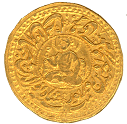


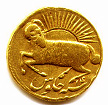
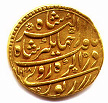
The silver zodiac coins were minted for only five months in 1618 AD or 1027 AH (regnal year 13) while gold zodiac mohurs were struck for full five years. Most of gold zodiacs were minted at Agra while most silver zodiacs (but not all) were primarily minted at Ahmadabad. Few silver coins were minted at Agra using dies for gold zodiac mohurs. Shown above is that very rare silver coin which was struck from dies which were used for making gold zodiac Mohurs.
Because of their `non-Islamic' nature, Jahangir's successors recalled these coins from circulation and melted them in Royal mints. But because of their tremendous popularity, they were extensively imitated and restruck ever since they were recalled from circulation. Often they were restruck for presentation purposes. Shown below is an early resrike, most likely from early 18th century, soon after death of Jahangir . Again this is a rare coin showing the Ram or Aries zodiac sign.
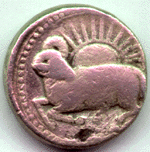
Some of the Jahangir's coins were in gigantic in dimensions. It is mentioned in `Badshah Nama' that on Jahangir's birthday the Persian Ambassador was presented with 4 Gold Ashrafis wighing 400 tolas (4.6 Kg), 300 tolas (3.5 Kg), 200 tolas (2.3 Kg) and 100 tolas (1.2 Kg)! Shown below is the image of the coin (the only coin in this webpage which I do NOT have) which is world's biggest gold coin and thus obviously world's most expensive coin. This coin has diameter of 20 cm and contains 383.75 troy ounces or almost 12 Kilograms of pure gold!
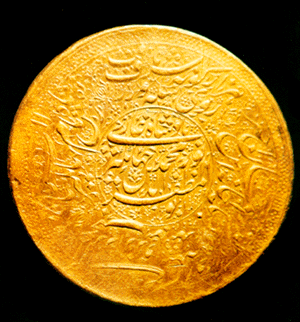
The gigantic Mughal coins are of special importance in Indian as well as world numismatics. One thousand tola gold mohur of 12 Kgs minted by Jahangir in 1613, realistically display the wealth that was accumulated by this dynasty. Most of these gold muhars/mohurs had poetic couplets in persian and were the finest samples of craftmanship and metallurgy.
Shown below is a scarce coin of Jahangir minted at Elichpur (northern Maharashtra state).
Shahjahan took control of Mughal empire after death of Jahangir. Throughout his reign the empire was very prosperous and stable. This stability allowed him to take up many massive construction projects. One of the most important being the world famous `Taj Mahal' built for his wife Mumtaz Begum. After her death, in memory he built this magnificent monument. The beauty and elegance of this monument is beyond description and millions visit every year to see it. Shahjahan built many other monuments during his reign. In his last days his son Aurangzeb took control of this dynasty (1658 AD). Shahjahan was imprisoned where he died 8 years later in 1666 AD. Shown above is image of his coin which is in uncirculated condition and have the original shiny finish (thus making difficult to scan).
Aurangzeb was truly the last Mughal. He inherited a great empire and througout his 49 years of reign tried to keep it intact. Unfortunately, unlike the Akbar and his later successors, he was very fanatic Islamic ruler. His rule witnessed re-introduction of religious tax Jizia, which he imposed on Hindu population and the persecution of majority Hindu population was continued under his patronage. This created a tremendous displeasure and religious tension among many of his generals who were mostly Rajput warriors (Hindus). He lacked sympathy, imagination, breadth of vision and elasticity of choice of means. In spite of vitality and ceaseless campaigns again his enemies, Aurangzeb proved to be a failure as a ruler of India. In the intensity of his religious zeal, he ignored feelings of important sections of people (who did not profess Islam) and thus roused forces hostile to his empire.
In Deccan , Marathas, another Hindu warrior clan, united under able and wise king Shivaji Bhonsale. Aurangzeb spent last decades of his life fighting Marathas in south. In spite of his allout efforts to suppress Marathas, the spirit of religious freedom and independence was not lost in south. Soon after his death, his empire disintegrated and Marathas emerged as a supreme power in India. Shown above is a nice example of the silver rupee minted during Aurangzeb's reign.
After death of Aurangzeb, war broke out between his sons for throne, the first sign of collapse of Mughal empire. Aurangzeb was followed by his eldest son Muazzam under title of Shah Alam I, after killing two of his younger brothers. He soon died in 1712 and thus war of succession started among his 4 sons. His eldest son Jahander shah emerged as a victorious. He killed his three other brothers and became emperor. Jahander Shah was completely under enfluence of his favourite lady Lal Kumari. His brief reign was full of violence but mistrels, singers, dancers and actors had great time. He was hopeless ruler and finally deposed by his nephew Farrukhsiyar in 1713. Jahander Shah was strangled to death and his cheif minister was also executed. Farrukhsiyar was elevated to throne by two Sayyid brothers who were governors of Patana and Allahabad. Farrukhsiyar was feeble, coward and had no vision. He acted ungratefully towards Sayyid brothers. They resented this and eventually they deposed him, blinded him and had him executed.
Now sayyid brothers `the king makers', elevated youth of eighteen, a cousin of Farrukhsiyar, Roshan Akhtar to throne. He ascended the throne under the name of Muhammad Shah. He soon managed to find him powerful supporters including Nizam-ul-mulk of Deccan. In a very smart move, he killed both the Sayyid brothers and thus his long reign of 29 years started. He was young and fond of all kinds of pleasure (he is also known by another name, Rangeela, the careless fun-lover). His reign was full of utter confusion and he let the emperial affairs drift their own way with fatal consequences. Major provinces like Deccan, Oudh and Bengal slipped away, Marathas created their own massive kingdom and became very powerful. Thus within three decaded after death of Aurangzeb, the vast Mughal empire spit into numerous independent or semi-independent states. Shown above is an extremely fine gold coin depicting his name, title, mint name and year (scarce to see all these on single coin).
This section is currently under construction. I am putting together more
images of coins and lot more interesting information. Come back soon!
If you have any comments, please send at
This page is divided into following sections: